Estimated reading time: 6 minutes
Knowing how to use renovation pruning to tame monster fruit trees is a useful tool for many new homeowners.
Moving into a new property with existing fruit trees can be very exciting. It offers the promise of ready-made fruit harvests outside the back door without having to plant trees or wait years for them to mature.
The reality can be very different!
Inheriting fruit trees: gift or headache?
When you buy a property with established fruit trees, you’re often inheriting someone else’s problem.
You know the ones – the “monster” trees that have been abandoned, neglected, or just unloved. They can get a little wild, like the big plum tree on the right in the photo above.
We should also acknowledge that sometimes you’re inheriting these trees from your former self. Back then, you didn’t know how—or have time—to prune them properly. (We’ve all been there, give yourself a break…)
The important thing is that you learn how to prune your trees using our foolproof 7-step method.
Can monster fruit trees be brought back from the brink?
Getting monster trees under control is possible, but it needs a bit of specialist care. We call it renovation pruning. As the name suggests, it’s all about bringing trees back into good repair and productivity.
How would you prune trees like these?
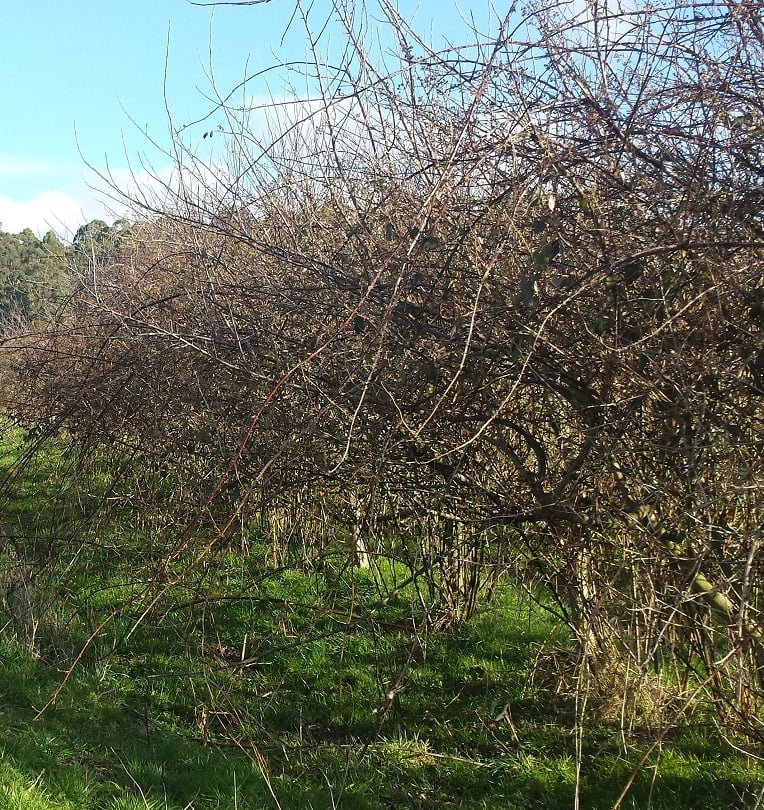
This example is actually a whole lot of monster trees in an organic orchard that was left unpruned for a few years. They were neglected for years and ended up crowded, tangled, and full of blackberries.
Here’s another typical example of a backyard fruit tree that got away:
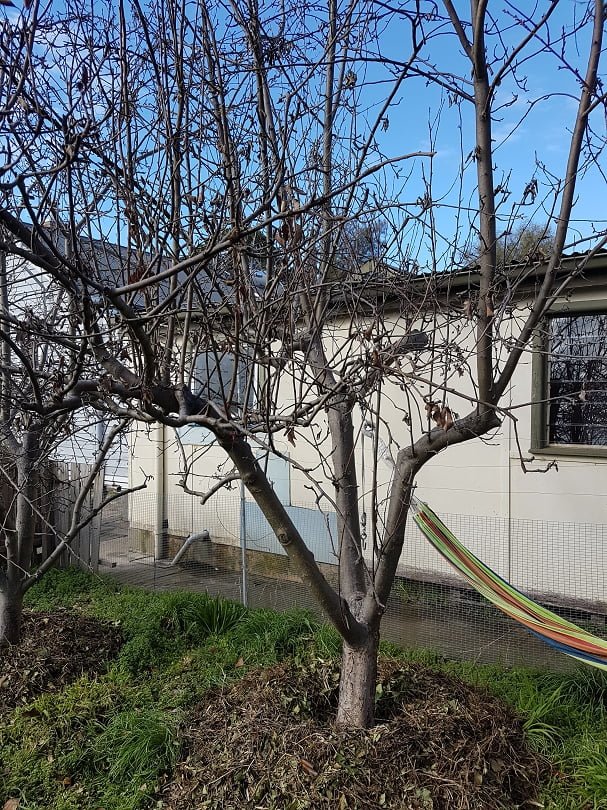
In both cases, the trees are still healthy. So, the good news is that it’s completely possible to bring them back into production and make them manageable again.
If you’ve inherited some fruit trees that haven’t been cared for for some time, don’t despair.
The renovation pruning approach
Here’s how we’d approach the first example (you can modify these instructions to suit your own situation, of course):
- Firstly, remove all the blackberries. This can be a challenge because blackberries love to regrow. A combination of grubbing out as many canes as possible and cutting the rest very low will get you started. Following up by grazing with sheep or goats is an excellent idea if possible. If not, mowing regularly should gradually get rid of them. We wouldn’t use poison on them around fruit trees, because it’s not good for the soil.
- Start pruning by removing any dead wood from the trees. This allows you to see what you’re working with.
- Decide what shape of tree you’d ultimately like to achieve, e.g., ‘vase’ or ‘central leader’. Start thinking about the permanent limbs you’re going to keep in the tree to give you the best approximation of that shape.
- Remove limbs you don’t want. If you’re not sure at this stage, leave them in. You can always remove them later, but you can’t put them back.
- Reduce the height of the tree by pruning each retained permanent limb down to a lateral that is at the right height to become the new ‘leader’ of that limb.
- Now do the regular maintenance pruning job on each limb. Start from the top and work down to the bottom of the limb. Make a decision about how to treat each lateral (or side branch) as you come to it. Your choices boil down to either leaving them alone, shortening them, or removing them.
Does renovation pruning work?
In most cases, categorically yes!
Here are the same trees after the first year’s renovation pruning. The blackberries have started to be removed, suckers have been cut out, some limbs have been taken out of the tree, and some lateral growth shortened. They’re starting to look like fruit trees again!
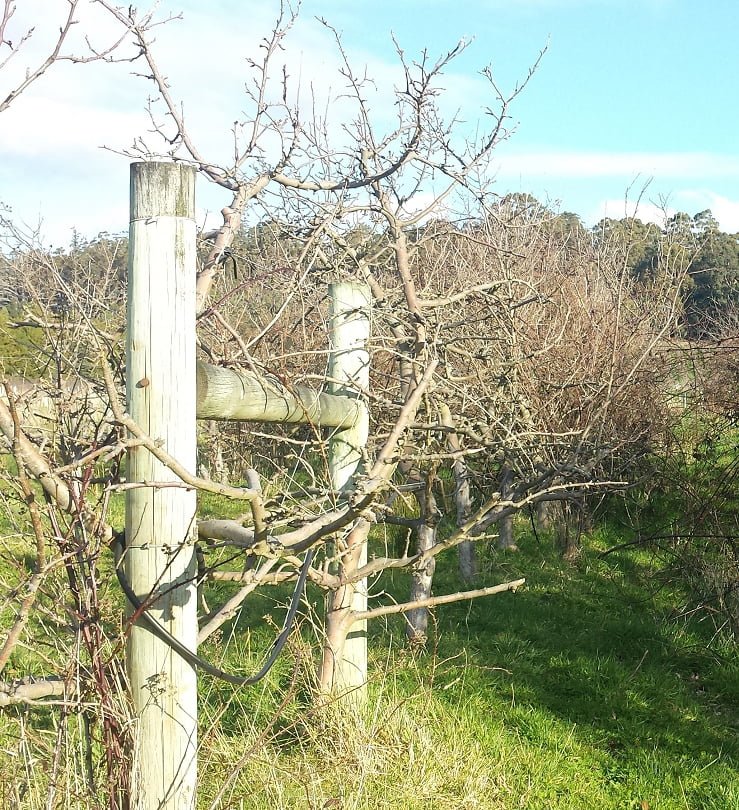
Take your time with pruning
Renovation pruning has many challenges. One of the main ones is the fact that when you remove a large amount of wood, you’re likely to stimulate the tree to grow a whole lot of new wood to replace it. This is likely to occur at the expense of growing fruit.
The way to minimise the shock to the tree and help keep it calm and fruitful is to create a renovation pruning plan over a number of years.
Renovation pruning can take quite a few years to re-establish a calm tree at the right height to be useful. The larger the tree, the longer it might take you to finally get it under control.
It can take patience and perseverance. But converting a useless and stressful monster into a useful and productive fruit tree is totally worth the effort.
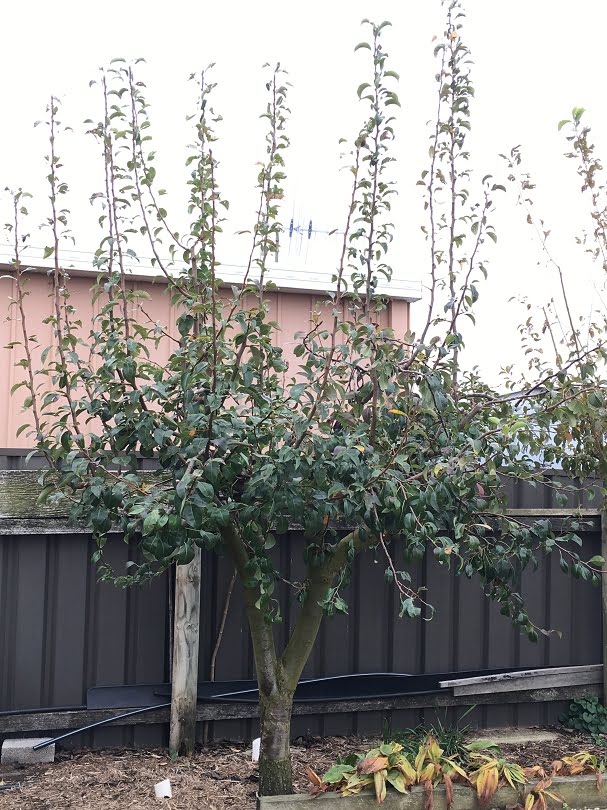
Related Articles
How much fruit will your tree produce?
Working out how much fruit a mature fruit tree can grow will help you plan how many trees you need in your garden to meet your family’s needs.
How to prune your apple tree
Pruning apple trees takes a little more specialist knowledge than other fruit types, but your trees will reward you with ample crops.
How to plant a fruit tree – the easy way
Everything you need to know about how to plant your new fruit trees to get them off to a great start in life.

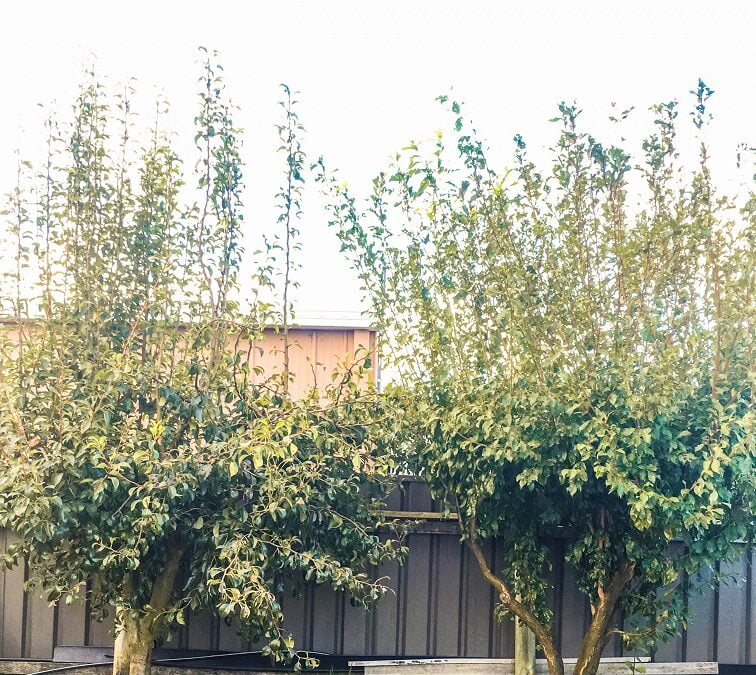

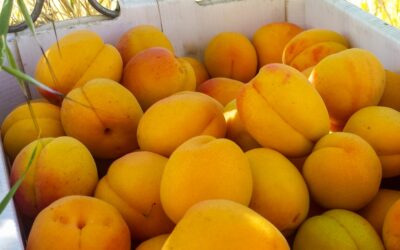
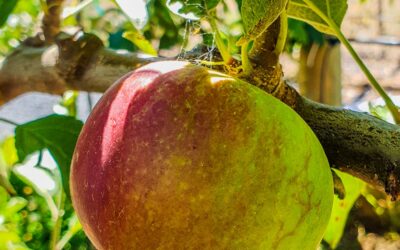



In the photo of the apple tree with the hammock in view, is that just grass clippings used as a mulch?
Sharon
It is Sharon. We normally recommend either a living mulch (ie plants) or woodchips as the best mulches, but any organic matter going back into the soil is helpful.
My apricots trees have a lot of that black spot on the fruit each year. I have been spraying them every year with Bordeaux mixture and the copper oxychloride I replaced it with says ‘not apricots ‘.
Why not apricots? Is the black spot not a fungus?
Jill Atherstone
Wow! That tree there had been neglected since it’s rooting!
On that monster plum tree that is shown 1 year after reno prune, what do you do with those multiple long vertical branches? Is it a big haircut? Or other special prune?
I think I’ve over pruned my peach tree! Have I killed it😳
Well, time might tell Tania! What season are you in? If the tree is still in winter dormancy, keep an eye out for fruit & leaf buds and watch what they do. And, we’d suggest checking for the graft union so you know that you’ve definitely pruned above the graft. If nothing happens in spring, then that might mean the tree has died. But, it might not be your pruning – there can be lots of reasons a tree might turn up it’s toes. Hoping for the best for your peach tree, Meg – Grow Great Fruit team.